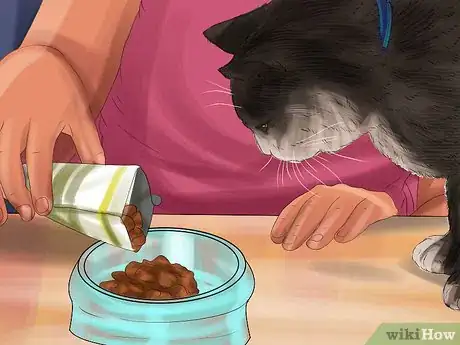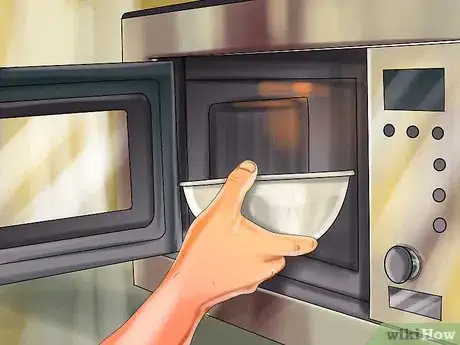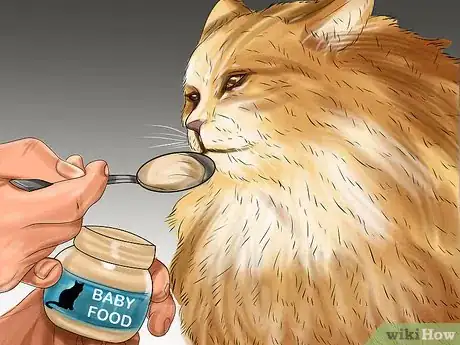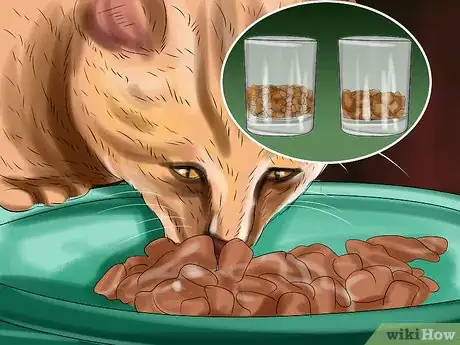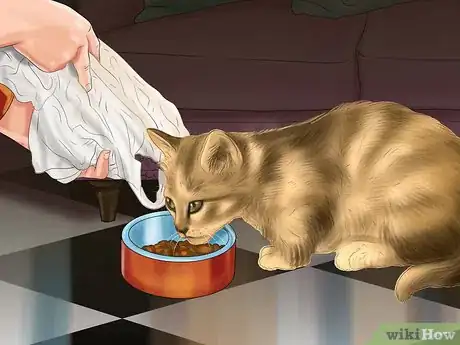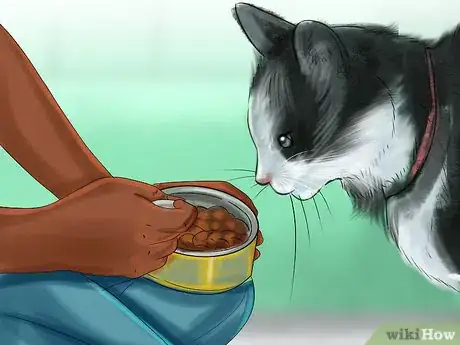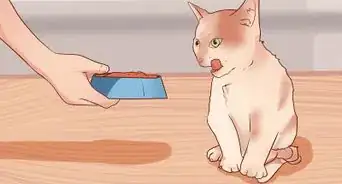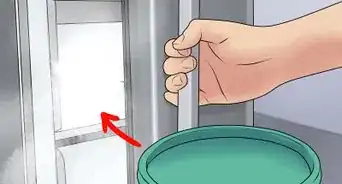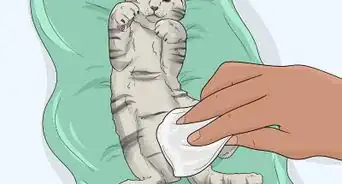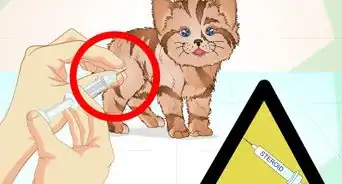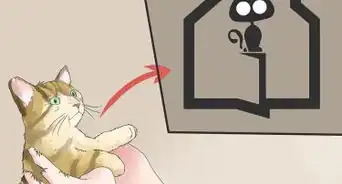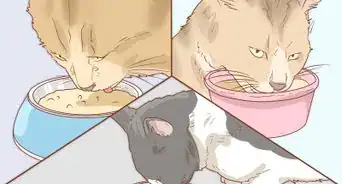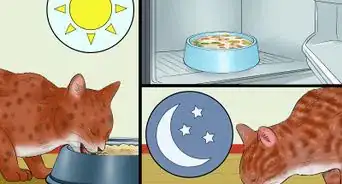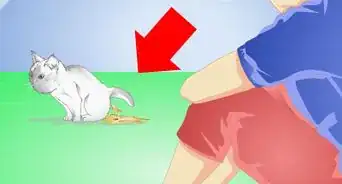This article was co-authored by Pippa Elliott, MRCVS. Dr. Elliott, BVMS, MRCVS is a veterinarian with over 30 years of experience in veterinary surgery and companion animal practice. She graduated from the University of Glasgow in 1987 with a degree in veterinary medicine and surgery. She has worked at the same animal clinic in her hometown for over 20 years.
There are 9 references cited in this article, which can be found at the bottom of the page.
This article has been viewed 77,485 times.
Cats are finicky creatures, and they may go off food when they are sick or getting older, for instance. If your cat suddenly stops eating, you should definitely take it to the vet for a checkup, as it may have an underlying problem. Otherwise, you can work on the cat, environment, and food to encourage your cat to eat, as well as use a few tricks when switching foods.
Steps
Changing Behaviors to Help the Cat
-
1Feed the cat alone. If there are other animals in the house, the cat may feel uncomfortable eating, as it tries to compete for food. If you section off a room where you can feed just that cat, it can increase the chances of the cat eating.[1]
-
2Give smaller meals. Smaller meals throughout the day may seem counter-intuitive, but it can actually encourage your cat to eat. If your cat doesn't have a large appetite, it may be overwhelmed by a large bowl of food.[2]Advertisement
-
3Offer comfort and attention. Some cats want attention when they're eating. Try stroking your cat and talking soothingly to it while it's eating. You can also try a bit of petting if your cat is near the bowl but not eating. This tactic won't work with every cat, though, so if your cat seems disturbed by the attention, leave it alone.[3]
-
4Wipe the cat's nose. If the cat has been sick, it may not be smelling very well. Wiping the cat's nose and trying to remove discharge may help it smell better. In turn, it may be more interested in food because it can smell it.[4]
-
5Hand feed the cat. A cat who hasn't been interested in food may be more inclined to eat if you hand feed it. For canned food, you can put a little on your finger and offer it to the cat. For dry food, place a bit in your hand, and hold it out for the cat to eat.[5]
Making Food More Palatable
-
1Warm up the food. Another way to encourage a finicky cat to eat is by heating up the food just a bit. Even kibble will benefit from this treatment. You don't want it too hot to eat, but a little bit of warmth will help release the scent of the food, which makes a cat more receptive to the idea of eating the food.[6]
-
2Try canned food. If your cat has been on dry food and has seemed reluctant to eat, switching to canned food may help. Canned food releases more scent, encouraging your cat to eat.[7]
- If you mainly want to stick with dry food, you can add a little wet food to the dry to encourage your cat to eat it.
-
3Add a little tuna water on top. If your cat isn't wanting to eat, increasing the good smells of the food may help. Pour a little water from a can of tuna packed in water (not oil) on top of the food. Most cats will be more than happy to eat anything doused in tuna water.[8]
- You can also try clam juice or even Parmesan cheese.[9]
-
4Offer baby food. If you can't get a cat to eat at all, particularly a sick cat, you can try baby food for a time. Stick to all-meat products, as cats cannot have foods like garlic or onions. You can offer the cat a little on a spoon or your finger to get it started.[10]
Helping a Finicky Cat Switch Foods
-
1Mix the new with the old. Start by adding just a little bit of the new food to the old food. As days go by, gradually increase the new food and decrease the old food until eventually you're just feeding the new food.
- Switching foods may also help a finicky cat eat more, if it doesn't like the old food.
-
2Keep offering the new food. You can't just withhold the old food until the cat eats the new food, as that can be very dangerous for a cat. Instead, offer the new food for 30 minutes. If the cat doesn't eat it, give the cat a small amount of the old food instead. Remove the food when the cat walks away. If you practice this method a couple of times a day, your cat will usually take to the new food in a couple of days.[11]
- When cats don't eat, they can develop a problem with their liver, which can lead to death.[12]
-
3Be consistent when possible. For the most part, cats like routine. If your cat is happy with a food, try to stick with it, as changing can be difficult. If you're bringing home a new cat, it's a good idea to ask what food they've been on at the shelter, so you know what it's accustomed to.[13]
References
- ↑ https://icatcare.org/advice/how-guides/how-encourage-your-cat-eat
- ↑ http://www.peteducation.com/article.cfm?c=1+2140&aid=697
- ↑ http://www.peteducation.com/article.cfm?c=1+2140&aid=697
- ↑ https://www.vetwest.com.au/pet-library/feeding-a-fussy-eater
- ↑ https://www.vetwest.com.au/pet-library/feeding-a-fussy-eater
- ↑ https://vcahospitals.com/know-your-pet/managing-the-sick-cat
- ↑ http://www.peteducation.com/article.cfm?c=1+2140&aid=697
- ↑ http://www.vetstreet.com/dr-marty-becker/how-do-i-get-my-cat-to-eat-new-food
- ↑ http://www.peteducation.com/article.cfm?c=1+2140&aid=697
- ↑ http://lakemillsvetclinic.com/caring-for-your-sick-pet/encouraging-a-sick-pet-to-eat.html
- ↑ http://www.vetstreet.com/dr-marty-becker/how-do-i-get-my-cat-to-eat-new-food?page=2
- ↑ https://icatcare.org/advice/how-guides/how-encourage-your-cat-eat
- ↑ https://www.petfinder.com/cats/bringing-a-cat-home/tips-for-first-30-days-cat/

